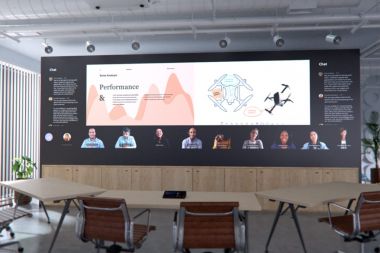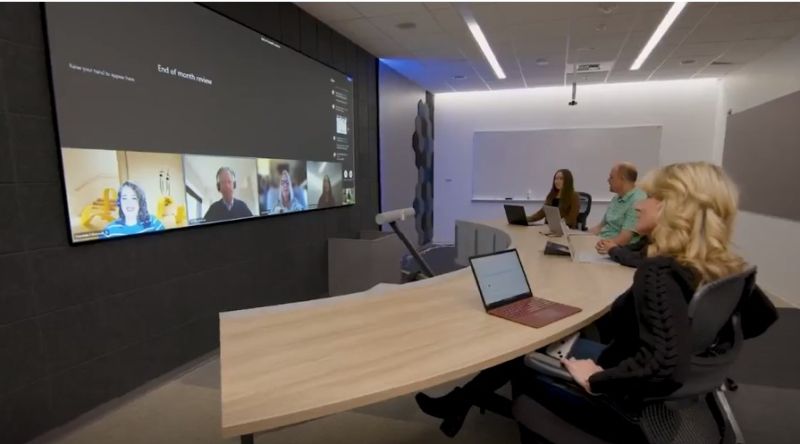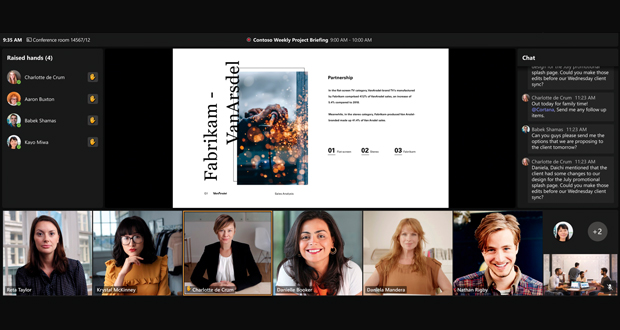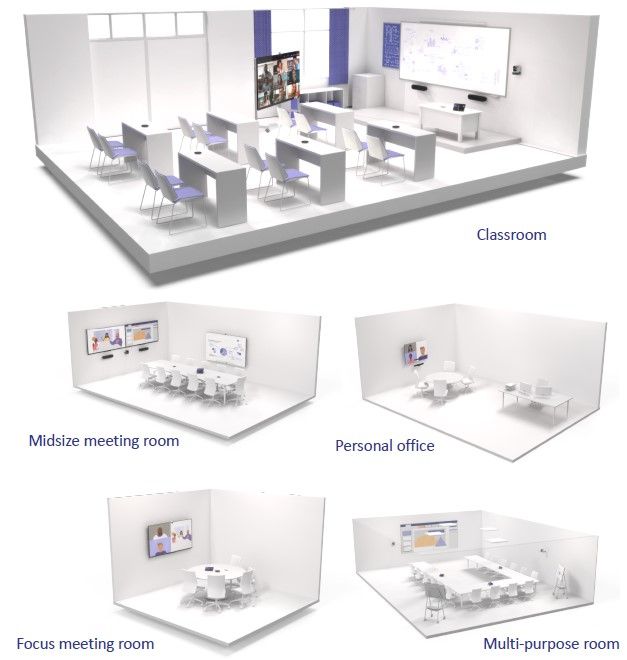Microsoft Teams Rooms: Opportunity knocks for AV
Microsoft Teams Rooms (MTRs) represent a once-in-a-generation business opportunity for the AV industry. Here, Greg Jeffreys explains how…

During Microsoft’s Q4 results and earnings call in July, CEO Satya Nadella said: “Hybrid work is now just work, and it’s imperative that organisations reconnect and re-engage the workforce at home, in the office and everywhere in between.”
Within Microsoft, Teams is classified as an incubator business, so it’s interesting to ponder how big it thinks this baby will grow.
Yet, as positive as this sounds, some end users question whether the AV industry can service all its hybrid needs. Structural changes lie at the root of such concerns.
Once upon a time AV professionals had the simpler task of fitting out spaces with AV technology. Meeting rooms and teaching spaces were handed over as done deals to AV consultants or design-and-build AV integrators. ‘Here’s the space, please fit the equipment in here – and wipe your feet on the way out.’
The move to hybrid working and teaching left this practice at the roadside, for the room design and configuration themselves can cause workspace failures, no matter how advanced the room equipment that is finally installed. It didn’t help that the pandemic-driven 2020/21 rush to retrofit and create hybrid spaces meant that specifications were created before workflows and use modes were understood, combined with ignoring AV standards when they were most needed.
The move to hybrid working thus created a void in conventional AV design and installation practices when space design and configuration moved above the UC equipment specifications in importance. Tradition and expediency between user and supplier might make it an easier working assumption that whatever the hybrid space design questions are posed, the equipment specification and vendor choice will always supply the solution. Space configuration and design represent the road less travelled for AV professionals, one that leads us away from our comfort zones.
Microsoft moved to fill this void by focus on the room design itself, on the creation of good user experience in the 3D physical space that its vendor partners’ equipment then completes. The Microsoft ecosystem supports and promotes its partners’ certified devices, but they have walked a solitary path as the new principles of space design have been emerging.
Consider how unusual it is for a company of Microsoft’s heft to show such thought leadership in developing room design innovations when Zoom, Webex and all other platforms can equally benefit. Decades ago, it was the one to squash the pesky Netscape browser. Now the company lives in a world where interoperability and structured Open Source access to its apps just makes its markets ever larger. President Roosevelt’s maxim of ‘speak softly and carry a big stick – you will go far’ is reflective of Microsoft’s confident MTR stance.
So, what exactly has Microsoft been doing?
Some describe it as addressing a ‘pre-technology’ need or assessment, acknowledging the need for ‘tech prep’ project phases. These processes must be completely tech literate, but also follow proper UX design principles of working to describe user needs in tightly defined and measurable outcomes before the technology toolbox is opened and vendor and equipment choices are made.
Tracking Microsoft’s progress here falls roughly into three, half-yearly phases. The second half of 2021 saw the release of Bringing Microsoft Teams to your meeting rooms (1), co-authored by Jimmy Vaughan, who has since become a media star in the MTR world (and who took one for the Teams by coming to ISE to catch Covid from us). If you download this magnum opus, you’ll see photo-realistic renderings of first pass designs for space designs, for displays and – unsettling for many – early views of the Front Row layout.
To be clear, Front Row is a screen layout, a user option within the Teams environment. It is spearheading Microsoft’s development of screen designs for Teams room displays and its consideration forms an essential part of the process of display specification.
At first view, most striking of all was Microsoft’s step change to radically larger display sizes, plus new widescreen aspect ratios, courtesy of Front Row. Equally striking was its move to projection to create these displays, a challenging prospect to those for whom whatever the display question might be, the answer was always some size or type of large format display. Times have changed. But again for those who opt to execute projection suitably for MTRs there are manifold opportunities.

The Introducing The Hive video in May 2022 was when the new MTR Enhanced Meeting Room went public and Front Row finally settled on a 21:9 aspect ratio using projection – for the time being
The first half of 2022 saw further releases of photos of early installed realisations of Front Row systems in The Hive (Microsoft’s Teams Room R&D centre), including some intriguing VC camera positioning, but this period also saw Microsoft move away from 32:9 twin projector systems and to fix firmly on 21:9 single projection for its widescreen Front Row layout. In February Front Row itself was released. But it was the launch of The Hive video: Meet The Hive: Transforming how meetings happen at Microsoft with Microsoft Teams Rooms (https://youtu.be/eS3efXIKjpA) in late May where this specification was confirmed with two spaces featured, both with large 21:9 projected displays – and with significant additional room design features.
The second half of 2022 will be all about how these designs will be deployed and adapted. This merits a close look at what these designs include and, perhaps equally significantly, what they exclude.
The exclusions are significant. It’s not yet clear – possibly even to Microsoft – how far to take these designs, or to present them as systems that can be deployed cookie-cutter style. A senior Microsoft manager recently confided to me how unjust he’d found a recent comment from a client expressing disappointment in their MTR experience. An investigation showed that poor audio system calibration to be the cause. This single example highlights the reputational risks even the mighty Microsoft faces – and its reliance on third party vendors.
One senses that Microsoft wants final responsibility for delivery of good user experiences across the range of room types and sizes to rest firmly on the integrators’ side of the fence. But a simple BOM (bill of materials) approach risks failure. Paying for something does not guarantee it will work well for you. The identical and expensive projector and screen can look anything from superb to dire when correct standards are not followed.
Even the use of the word ‘standard’ can be problematic, often flying under a flag of convenience where its meaning flexes to suit the needs of its user at any given moment. Yet here is a mission-critical need for rigour and consistency. The challenge is not to create individually good or good enough hybrid spaces. It is to create room designs that are globally deployable, consistent, and with measurable and certifiable outcomes. For this, ‘performance standards’ are needed, whereby good user experiences are defined and can be measured. It’s no coincidence that AVIXA’s AV standards are mainly performance standards…
The renewed focus on standards is an awareness issue for us on AVIXA’s standards committee, which I chair. It helps that AVIXA has created the Xchange for members, for which content is being developed to help all parts of the AV ecosystem work with AV standards as living, breathing entities that can be used critically and creatively, not least in hybrid space design and certification.
From theory to practice – from designs to installed systems at The Hive
The Hive is equipped so that new designs and concepts can be created and tested immediately, sometimes within a matter of hours. They take pride in taking jigsaws to cardboard block sheets and sticking the bits together with gaffer tape to accelerate the design and test iterations.
When re-presented in the form of videos of installed systems at The Hive this May, they retained something of the conceptual about them whilst still pushing new boundaries.
The principal space at The Hive was built from scratch and is referred to as an enhanced meeting room (EMR). Adherents of the old telepresence systems are happy to see the single row of in-person participants in this design, but here it’s in a shallow arc so the five or six people can make eye contact with each other, as well as the remote participants.
The second space at The Hive is billed as a refurbishment, acknowledging that most new hybrid spaces will be refreshes of existing meeting and teaching spaces – and that the majority of MTRs will not have the kind of budget that EMRs demand. However, it also shows that Microsoft sees the 21:9 Front Row aspect ratio working in conventional room shapes too. The ‘gumdrop’ or ‘guitar pick’ table here can be extended into something more like the conventional ‘bowling alley’ configuration, albeit with more tapering in the table shape to maintain in-person eye contact and camera coverage.
Front Row has created confusion in the minds of some, but the thing to remember is that it is only a screen layout. Although Front Row is also supported in 16:9, the 21:9 aspect ratio is where it really works, where the content panels with the row of remote participant images are ranged below, as close to lifesize as possible.
Front Row screen layouts require critical application of AVIXA’s DISCAS (3) standard to calculate minimum display sizes needed. DISCAS is based on image height. The Front Row main content window is effectively a picture-in-picture (PiP) inset within the display, typically around 60 per cent of the display height. So DISCAS has to be applied to that content window. Starting with the default metric of 6:1, where if the farthest viewer is six metres back then the image height must be at least one metre, then this metric changes to 3.6:1 when applied to this smaller main content window.

The Front Row layout in 21:9 aspect ratio allows multiple content windows to be displayed concurrently and consistently
The Hive is built like a film set with rooms built in completely light controlled spaces. Both featured spaces use projection in UST (ultra show throw) lens format with the projectors mounted either just above or below the screen. The controlled lighting at The Hive, coupled with the acute angle of projection has dictated the use of low gain, contrast enhanced screen materials. Designers and integrators who have to achieve AVIXA ISCR image contrast standard compliance under normal lighting scenarios, including natural light, use ALR (ambient light rejecting) screen materials.
Current Hive rooms feature Epson projectors, one low-cost HD signage model in the refurb space, plus the premium EB-PU projectors fitted with UST lens in the EMR. Early engagement in this project meant that Epson upgraded the firmware to include 21:9 EDIDs on both models for connection with MTR Compute PCs. No doubt the other projector manufacturers will add these EDIDs soon, if not done already.
For users who need to create new MTRs now, yet are not confident that they will use 21:9 aspect ratio in all use case scenarios, they install 16:9 screens in the largest size possible, meaning 21:9 Front Row can still be used in the form of a reduced height band within the overall image area, at full width. For standard room heights of 2.7m (9 ft) this usually equates to a 120in image of 2.7m x 1.5m.
The move to much larger display sizes was theoretically problematical for VC cameras as this tends to push the camera to the margins. Microsoft’s quiet revolution in the camera position (and its legendary creation story by Sam Albert at The Hive) has created almost as much of a stir as the whole Front Row display innovation. Positioning a small form factor camera into free space in front of the screen marks a new era in VC camera positioning, one that can solve the problems that medium and larger hybrid spaces pose.
Lighting presents a new opportunity for AV. Hybrid space design demands that the VC camera is treated like a VIP guest and delivers good clean video signal to remote participants. This can only be achieved with good lighting. Even if, or especially if, a given space has poor lighting, there are PoE (Power over Ethernet – PoE) LED lighting systems that can be driven from the rack, so AV professionals can bring VC lighting into their domain.
Audio remains a trailing element in MTR technology deliverables. Microsoft has set the objective of full duplex spatial audio, where the remote speakers’ voices emanate from their onscreen position on the screen. Spatial audio has been a longtime feature in cinema, but its deployment in MTRs remains apparently inconsistent.

The EMR at The Hive uses the Jabra Panacast 50 soundbar, creating tension between the audiophiles and those who seek ‘good enough’. But there will always be this dynamic between those who strive for the best and those for whom gravity applies in the form of fixed budgets.
The Hive’s two featured spaces do not therefore represent the very top of the pyramid in MTR and Front Row design. They mark a purposeful step back from laying claim to being ‘ultimate’ systems – a fool’s game in any case bearing in mind the speed of change we’re witnessing.
Microsoft’s designs are only the tip of an iceberg whose true mass comprises the expedited UX journey they took to create these exemplars. The real paydirt comes from mining within these learnings.
Acknowledging this changed environment where space design and configuration are essential preconditions for successful MTR deployments does not of itself fix problems. Organisations are often heavily siloed; facilities management and AV will need to forge new working relationships, for example. AV’s traditionally fractious relationship with the architect will need to adapt to the owners’ need for the technology-enabled spaces to create better occupancy rates and higher rents.
The symptom of this new landscape will be the adoption of new working practices, evolving relationships between existing teams, creation of new team structures, plus changed relationships and expectations between users and suppliers. Here lie the opportunities.
Notes
1 Bringing Microsoft Teams to your meeting rooms
2 The Hive video (https://youtu.be/eS3efXIKjpA)
3 AVIXA’s DISCAS standard (https://www.avixa.org/standards/discas-calculators/discas)
Visit the AV Magazine website to stay up-to-date with all the latest AV industry news.
Posted: 21st October 2022